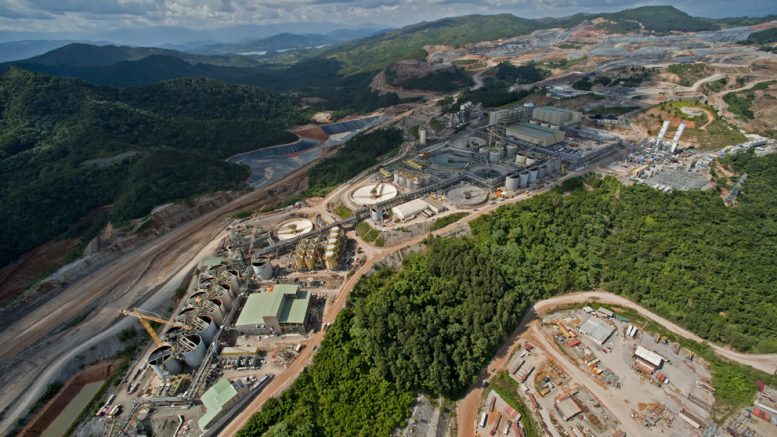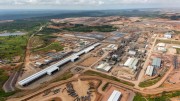The Northern Miner put together the largest global gold reserves at operating mines in 2016, using the Intelligence Mine database from sister company Infomine. The list excludes combined reserves at mine complexes such as Freeport-McMoRan’s (NYSE: FCX) 26.8 million oz. Grasberg copper-gold operation in Indonesia and Detour Gold’s (TSX: DGC) 16.4 million oz. Detour Lake operation in Ontario, Canada.
1. South Deep, South Africa
Gold Fields’ (NYSE: GFI; JSE: GFI) South Deep, which is the only mechanized gold mine in South Africa, takes the prize. The underground mine is 45 km southwest of Johannesburg in the Witwatersrand basin. As of December 2015, South Deep had proven and probable reserves of 37.3 million oz. based on 218.8 million tonnes at 5.30 grams gold per tonne.

South Deep is 45 km southwest of Johannesburg in the Witwatersrand basin. Credit: InfoMine.
During the first half of 2016, South Deep produced 140,000 oz., up 87% from a year ago, due to higher volumes and grades. All-in sustaining costs were US$1,268 per ounce. As a result, Gold Fields increased the full-year guidance to 289,000 oz. from 257,000 ounces.
Despite this, the troubled mine has failed to deliver the expected 700,000 a year until 2057, with the mine life ending in 2080.
South Deep is a gold magmatic sulphide and placer deposit, with uranium. The mine workings are accessed through two shaft systems, including one with a main shaft that goes down to 2,995 metres, making it one of the world’s deepest mines. Gold Fields employs long-hole stoping and drift-and-fill extraction.
South Deep, known as Western Areas Gold Mine until 2000, started commercial production in 1951. Gold Fields acquired full ownership in 2007 and first reported positive free cash flow at South Deep in the second quarter of 2016.
2. Olimpiada, Russia
Polyus Gold International (LON: POLG) is Russia’s largest gold producer and Olimpiada is its largest operation, accounting for more than a third of the company’s total production. The conventional shovel and truck open-pit operation sits 185 km north of Lesosibirsk in the Krasnoyarsk region.
At year-end 2015, Olimpiada contained proven and probable reserves of 29.1 million oz. from 274 million tonnes at 3.29 grams gold. Its estimated mine life is 38 years.

Polyus Gold’s Olimpiada gold mine in Russia. Credit: Polyus Gold.
During 2016, total output — including refined and concentrate — was 943,000 oz., which is up 24% from the previous year. The increase came from higher processed volumes, improved recoveries and an increase in gold contained in concentrate production. While full-year 2016 financials are not in, Olimpiada had all-in sustaining costs of US$560 per oz. in the third quarter.
The mine began production in 1996. Polyus uses flotation and bioleach processing to treat the ore on-site at two plants with a combined annual capacity of 8 million tonnes.
3. Lihir, Papaua New Guinea
Newcrest Mining’s (TSX: NM; ASX: NCM) Lihir deposit is on Aniolam Island in Papua New Guinea’s New Ireland province, 900 km northeast of Port Moresby. The gold deposit occurs in the Luise Caldera, an extinct volcanic crater that is geothermally active.

Lihir sits on the Aniolam Island in PNG’s New Ireland Province, 900 km northeast of Port Moresby. Credit: InfoMine.
As of December 2015, Lihir had proven and probable reserves of 28 million oz. contained within 370 million tonnes grading 2.3 grams gold. It has a 31-year mine life.
For the fiscal year ended in June 2016, the open-pit operation cranked out 900,034 oz. at all-in sustaining costs of US$830 per ounce. For fiscal 2017, Lihir should deliver 880,000 to 980,000 ounces.
Newcrest acquired Lihir in August 2010. Most of the ore is refractory and treated with pressure oxidation and a conventional leach process. Since starting production in 1997, Lihir has delivered more than 10 million ounces.
4. Cadia East, Australia
Newcrest’s wholly owned Cadia East hosts the largest gold reserve in Australia. The underground panel cave mine is part of the Cadia Valley Operations (CVO), which includes the Ridgeway underground mine and the Cadia Hill open-pit mine. Both of these are on care and maintenance.
Cadia East is near the city of Orange in central-west New South Wales, 250 km west of Sydney. As of December 2015, Cadia East contained proven and probable reserves of 23 million ounces (1.5 billion tonnes at 0.47 gram gold). It has an estimated 37-year mine life.
During the 2016 fiscal year, Cadia East delivered 669,000 oz., including ounces from Ridgeway, which went on care and maintenance in March 2016, after producing for 15 years. All-in sustaining costs were US$274 per oz., net of copper and silver credits.
During fiscal 2017, Cadia East should produce 730,000 to 820,000 ounces.
The mine achieved commercial production in January 2013.
5. Pueblo Viejo, Dominican Republic
Barrick Gold (TSX: ABX; NYSE: ABX) holds 60% of the Pueblo Viejo gold mine in the Dominican Republic, where Goldcorp (TSX: G; NYSE: GG) has a 40% interest. The open-pit operation sits 100 km northwest of the capital city of Santo Domingo.

The milling facilities at the jointly held Pueblo Viejo gold mine in the Dominican Republic. Credit: Goldcorp.
At year-end 2015, Pueblo Viejo had proven and probable gold reserves of 14.9 million ounces (156.5 million tonnes grading 2.97 grams gold).
Barrick and Goldcorp reported preliminary 2016 production from Pueblo Viejo of 700,000 oz. and 467,000 ounces. This puts the combined annual 2016 production at 1.16 million ounces.
Pueblo Viejo started commercial production in January 2013, and ramped up a year later.






Be the first to comment on "TNM Data Miner: Largest global gold reserves in 2016"